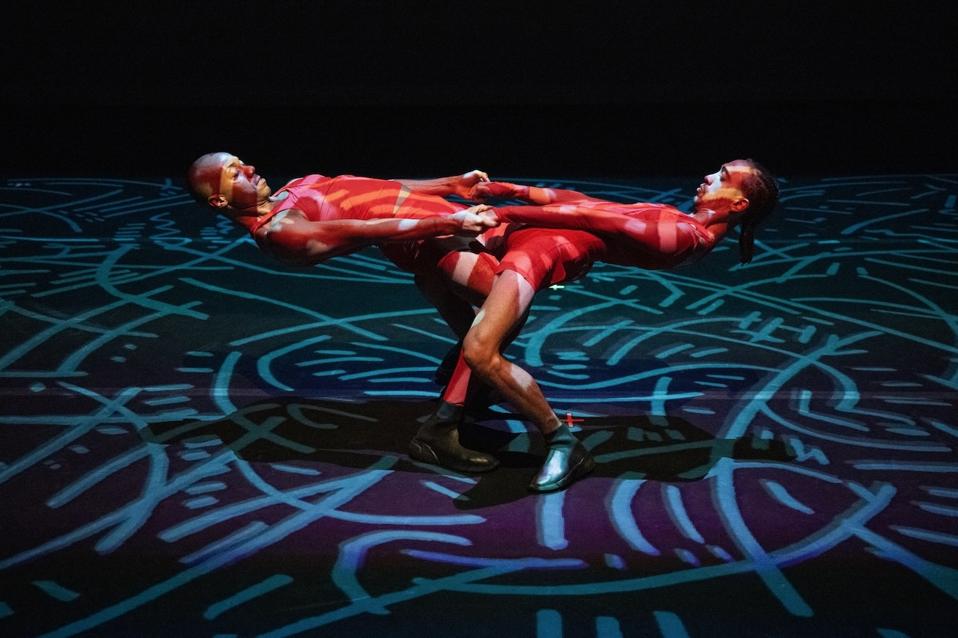Nearly five years after a fire destroyed a theater at the heart of a prestigious hub for dance in the Berkshire mountains, a gleaming new building has risen in its place. This one’s not only significantly larger than its predecessor, it’s equipped to incorporate all the technology dancers could imagine threading into their work — robots, artificial intelligence, augmented reality, motion capture, interactive video and more.
The Doris Duke Theatre at Jacob’s Pillow in fact, has staked a claim to an audacious title: “the world’s most technologically advanced theater for dance.”
Jacob’s Pillow is a 220-acre National Historic Landmark in Becket, Massachusetts, that houses a professional dance training center and hosts a long-running annual international dance festival.
The reimagined venue opened on July 9 to coincide with this year’s fest, which runs through August 24. The new theater — spanning 20,000 square feet, more than double the footprint of the former Doris Duke Theatre — includes a spatial audio system, infrared cameras to track performers for interactive video content and giant screens that double as kinetic canvases, among other high-tech flourishes.
“It’s a play space for artists and a site of discovery for audiences,” Pamela Tatge, Jacob’s Pillow executive and artistic director, said in an interview. “While the building and landscape are deeply grounded in the indigenous history of the land, it’s also future-leaning because of how it’s equipped and what it will provide artists moving forward.”
If all the technology packed into the new theater suggests a cold, futuristic steel edifice, the reality is quite the opposite. Dutch architecture firm Mecanoo designed a space that accommodates a robust technical infrastructure while remaining rooted in and inspired by the region’s natural beauty. The curved building has organic lines and a thermally treated pine facade designed to weather in harmony with the elements. The theater wall’s can close to immerse audiences fully in the technology or open to the outside. A veranda offers natural shading.
“We envisioned a magic wooden box which awakens the senses and deepens the connection between performer and audience, movement and space, light and shadow,” Francine Houben, Mecanoo’s creative director and founding partner, said in a statement.
Rising From The Ashes
The original Doris Duke Theatre opened in 1990, and the fatal fire engulfed it in November 2020. “It looked like what a bomb must look like when it goes off,” Tatge told The New York Times after the blaze. “It was just a pile of steel and wood.”
This month’s reopening, she said, “was such a collective expression of joy and possibility, particularly in the midst of such a challenging environment for the arts right now.”
The new theater opened with an inaugural exhibition, “Dancing the Algorithm,” which features immersive, interactive installations, including one that invites audiences to engage with a 360-degree film of an iconic solo by dance doyenne Martha Graham.
International artists featured in the exhibit underscore how dance doesn’t merely adapt to emerging technology, but shapes and challenges it. For example, an updated version of David Wallace Haskins’ “Time Mirror IV” (seen in the video above) uses AI-powered machine vision to detect human movements, then generates multiple real-time repetitions of them that ripple across the screen like a living time lapse.
Nora Gibson’s film “Artificial Dances” includes three vignettes created entirely with AI and scored with music created from the artist’s own biological data, collected by sensors.
“Being a dancer, I am interested in what synthetic intelligence means without the embodied experience familiar to humans,” Gibson said in an interview. “I wanted to answer this question through dance, and to also explore what creativity would mean for me when collaborating with artificial intelligence.”
The opening season for the new theater features two digital-first works designed to be experienced virtually from anywhere. One is Shamel Pitts’ “Touch of Red,” a duet inspired by boxing, Lindy Hop and nightlife culture that explores how Black men perceive themselves in the world. The other, from Elle Sofe Company out of Norway, blends dance with yoik, the traditional singing of the Sámi, an indigenous group inhabiting an area spanning parts of northern Scandinavia and Russia.
Tech-forward highlights of the season include “Dragons” from Korean choreographer Eun-Me Ahn, which incorporates 3D holograms of remote dancers with live, onstage performers. Taiwanese dancer/choreographer and robotics inventor Huang Yi will make his Jacob’s Pillow debut with “Ink,” a work that reimagines calligraphy in motion by pairing industrial robots and holographic projections with human dancers who use their bodies as brushstrokes.
“Artists who build their work in conversation with technology are no longer a subgenre of our field or a passing fad,” said Katherine Helen Fisher, the dancer and choreographer who curated the “Dancing the Algorithm” exhibit. “Their work is vital cultural practice, a frontline of social imagination.”

